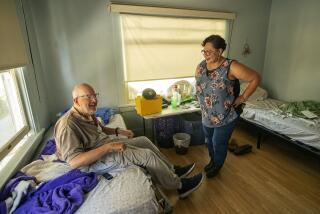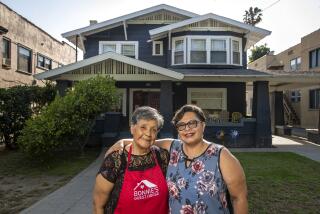County-Run Homes, Once Widespread, Now Dwindling
- Share via
SHELBYVILLE, Ind. — In a rambling brick building on the outskirts of this central Indiana city, Phyllis Doddridge has spent the last 32 years as a ward of the local government.
Her home all those years--Shelby Manor--hails from 1919. Originally, it was one of the so-called “poor farms” that began springing up in the late 19th century, offering indigents food and shelter in exchange for labor.
These days, they’re often the final stop for elderly who--by misfortune, poverty or the death of a spouse--have nowhere else to go.
Doddridge arrived here Nov. 28, 1962, after suffering a nervous breakdown. She passes her days embroidering, reading the Bible and taking walks around the manor, a two-story rural building bordered by a wrought-iron fence.
“I’d have to say I’ve been happy all the years I’ve been here. It’s been home to me when I haven’t had a home,” said Doddridge, 68.
Once welfare operations, the homes are now something between boarding houses and nursing homes. No one labors in fields anymore--most residents are elderly, and staff members prepare their meals, do their laundry and clean their rooms.
That’s a far cry from the “poor farms,” which were established with the goal of being self-sufficient operations where everyone who could was expected to toil in the fields.
The farms represented one of the first organized welfare efforts in American history, said Michael B. Katz, a professor of history at the University of Pennsylvania and author of “In the Shadow of the Poorhouse: A Social History of Welfare in America.”
Katz says the homes were generally feared by the public, who heard tales of the deplorable conditions often found in the farms’ living quarters.
“They were one of the worst and most dreaded institutions in the history of American society,” Katz said.
At the turn of the century, Indiana’s 92 counties each had a county home. Now, only 33 remain, a decline Katz attributes to the advent of Social Security and modern nursing homes.
“People who once would have been forced to go to these institutions in the past are now able to support themselves on their own because they have Social Security,” he said. “And the nursing homes take people who are mentally incompetent or simply too frail to take care of themselves.”
Only one “working” county home remains in Indiana: the DeKalb County home, known as Sunny Meadows, said Robert Dudash, the home’s superintendent and president of the Indiana County Home Assn.
Built in 1908 in Auburn, Ind., Sunny Meadows still boasts a dairy farm with some 100 head of dairy cows milked and cared for by a tenant farmer.
The cows provide the home’s 25 residents with five gallons of fresh milk each day; the remainder is sold to local diaries.
“They used to put everybody to work here, just like at the other county homes. But these days you only have to work if you want to,” Dudash said.
Although the farm provides Sunny Meadows with a source of income, most of the state’s surviving county homes are under extreme financial pressure created by rising costs and declining populations.
Those forces almost prompted the closure last year of the Eastside Residential Center in Columbus, Ind.
Superintendent Diane Burrell saved the home by slashing its annual budget from $264,000 to $180,000--a move accomplished chiefly by reducing full-time staff from nine to five, herself included.
Before the agreed-upon cuts were reached, the home’s 15 residents, with a median age of 74, were frightened, according to Burrell. “They were very concerned about losing their home, as anybody would be,” she said.
Among them was Betty Hamm, 46, who had been homeless for several years before she came to the center in 1987.
“I used to spend nights with my brothers or sisters, but they have families of their own to take care of so I just came here. I didn’t have any other place to go,” Hamm said.
Over the years, as the state has closed facilities for the mentally ill, county homes have seen an increase in mildly mentally ill and retarded residents, Dudash said.
“There are quite a few of them where the families don’t want them,” he said. “Most of them don’t want to be here, but they couldn’t strike out on their own.”
More to Read
Sign up for Essential California
The most important California stories and recommendations in your inbox every morning.
You may occasionally receive promotional content from the Los Angeles Times.













